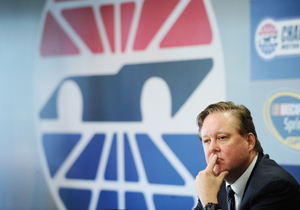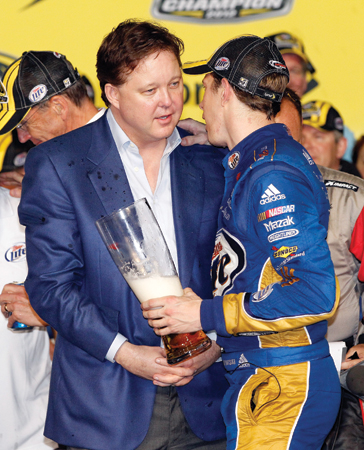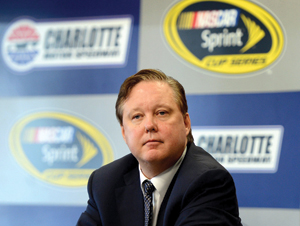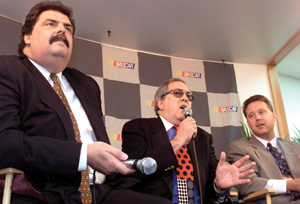Ten years ago this month, Brian France succeeded his father as chairman and CEO of NASCAR, becoming the third generation to lead the family business. In the decade that followed, the younger France has overseen the sport through trying economic times that have taken a toll on NASCAR attendance and seen TV viewership shrink and the sport’s sponsorship market go dry for a stretch.
 |
In 2003, Brian France became the third generation from his family to lead the NASCAR business.
Photo by: GETTY IMAGES
|
Yet NASCAR remains one of sport’s bigger guarantees, both in terms of reach and revenue. Its TV ratings, though down, remain among the industry’s elite, and France has parlayed that into massive new contracts over the next 10 years. The sport also has been proactive in improving competition with this year’s Generation 6 car, as well as out front and active with its Green Initiative, social media and striving for more diversity among its competitors.
France chatted with SportsBusiness Journal staff writer Tripp Mickle about his first 10 years in the job, his management style and the future of NASCAR.
MANAGEMENT STYLE
“I still like to get plenty of input, maybe more than people in my role might.”
When France stepped into the role of NASCAR chairman in 2003, he said he would manage the organization by seeking opinions from others, making a decision and then pushing the organization to act on that decision as quickly as possible.
Not much has changed about his management style over the last 10 years.
“I still like to get plenty of input, maybe more than people in my role might,” France said, “but once we’re going, we ought to be going fast.”
 |
France says he regularly discusses the sport with drivers like Brad Keselowski.
Photo by: GETTY IMAGES
|
If anything’s changed, it’s the way France has pushed NASCAR to become more collaborative with teams, drivers and manufacturers. He said the need for their input became clear following the Car of Tomorrow’s debut in 2007. The car was panned by drivers publicly and criticized by manufacturers privately.
When NASCAR decided to develop a new car for this season, France wanted the organization to take a different approach. Rather than developing the car independently, as NASCAR did in 2007, it worked directly with the manufacturers, providing them with specifications and allowing them to develop the cars. It then gathered feedback from drivers who test drove the cars. The resulting Gen 6 car, which debuted at Daytona in February, has been celebrated by manufacturers and approved by drivers.
“It was just a much more collaborative approach, and we undoubtedly got a better result from that,” France said.
Such collaboration has carried over to regular meetings with NASCAR owners, team executives and drivers. It also has a fan council it regularly consults.
In addition to that, France said he regularly speaks with drivers and owners about the sport. He talks with Brad Keselowski, Jimmie Johnson, Jeff Gordon, Joey Logano and other drivers and regularly encourages them to race hard. In the process, he listens to their insights about what could be done to make the sport better.
Keselowski earlier this year showed that he had a number of opinions on how the business could be improved during a wide-ranging interview with USA Today. He described NASCAR as a “house divided” and was reprimanded for it.
IN HIS OWN WORDS
On becoming chairman …
“I didn’t plan on being in the job. That surprises people. But when you had a father like I had who was doing a great job, you don’t think of those things.”
On his biggest
achievement …
“We dispelled the idea that NASCAR can’t rise to a higher level by the creation of the Chase and the moments that can happen. We’ve seen these big moments occur, and that feels good for the sport.”
On his biggest regret …
“I would say not getting the Car of Tomorrow launched in the way that we could have. That’s disappointing. I learned valuable lessons about collaboration, and you see that result in much of what we do today.”
On drivers …
“I’ll pull them [aside]. Mostly it’s to give them encouragement about competing hard. It’s their own style. It’s their own thing. … We want their personalities and skills to come out and them to have a good career here.”
On the 65-25-10 split
of TV money …
“I don’t think we want to get into trying to cut up certain slices smaller or bigger. It’s about making the overall pie bigger.”
On competition …
“We’re transforming the department to incorporate much more technology, much more science, as we develop the rules packages. We’ll get a much better result as time goes on regarding that.”
On team sponsorship …
“Sponsorship’s the lifeblood of the teams, but we’re showing improvement in that area, not deterioration.”
On NASCAR after Rick Hendrick, Jack Roush, Roger Penske, Richard Childress …
“They’ll advance their interest to a family member or someone else and their teams will march on.”
On car manufacturer
support …
“They’re starting to turn the corner on their own business. We’re working closely together with their marketing teams to demonstrate the untapped values that they have with their positions. We’re doing better than we have in a long time with manufacturers to get the most they can out of their involvement.”
On a new manufacturer joining NASCAR …
“There will be. It’s the biggest opportunity in motorsports in North America by a wide margin. … There is an opening now, and hopefully, someone will evaluate and look at taking things to the next level.”
On driver diversity …
“It’s taken longer than I would have thought to get some big gains. We’ve got a lot of smaller gains. We do have a number of drivers who are really showing some big promise, Darrell Wallace Jr. being one, but we will get there. It’s harder than it seems on the outside to find the right talent [who] wants to be there, but we will get there at the end of the day.”
On the future …
“We figure out digital social media in a big way with the millennial fan. We have this telemetry, technology that’s inherent in our sport. We have the rules packages where it elevates the level of competition and meets our promises to our fans. The tracks do their part to invest in facilities, amenities and technologies. And the sport’s in a really good place in 10 years, and I’ve never felt stronger about that given what we’ve been through and where we’re going.”
On his legacy …
“I tend to think we’ll look back and think that we made a lot of decisions that made things better and we never got away from the core promise of NASCAR, which is the closest, tightest and safest racing in the world. While we may have taken a road or two less traveled, we got to the right place and we dealt with everything thrown at us along the way and we maintained the sport they love. That’s what we’re trying to do.”
France said his relationship with Keselowski preceded the USA Today report and said he continues to speak with the 2012 Sprint Cup champion about what’s going on in the sport.
“We’ll have our moments where they’ll say something that isn’t accurate, and I’ll have to deal with that,” France said, “but by and large we just want them to compete and have a good time and let their personalities and skills come out.”
Among team owners, he regularly speaks with Rick Hendrick, Roger Penske, Michael Waltrip Racing’s Rob Kauffman and others, seeking their opinion on changes he is considering in the sport. For example, before NASCAR hired McKinsey & Co. to review its competition division, he spoke to Hendrick and got his insight on how changes to processes such as the parts approval system might affect teams.
Internally, he relies on a deep management team that includes NASCAR President Mike Helton; Steve O’Donnell, senior vice president of racing operations; Brett Jewkes, vice president and chief communications officer; Eric Nyquist, vice president of strategic development; and others.
“They get a lot of autonomy, but we’re not going to do anything large scale without those people having a chance to weigh in on things,” France said.
ENGAGEMENT
“I don’t go around beating my chest over that.”
Engaged is the word people often question when they talk about France’s leadership of NASCAR.
France believes the word captures the biggest misconception about him. He attends about 20 of the 36 Sprint Cup races NASCAR holds annually, and critics presume his absence at the others means he’s not involved in the business. France said that couldn’t be further from the truth.
“Being as engaged as I am surprises people when they talk to some of our people about how our staff meetings are run, how our executive management meetings are run and how the agenda is set,” he said. “I don’t think anybody on our team would say that I’m hard to find or not on the issues of the day. That surprises people because I don’t go around beating my chest over that, because that’s what you do day in and day out.”
When he’s not at races, France said he typically watches flag-to-flag coverage of the race on TV, checks NASCAR.com on his iPad, emails staff and calls executives across the company with questions or observations. Doing so allows him to keep track of all aspects of the sport, from TV to digital to race operations, and in his mind that can be as valuable — or more valuable — than being at the race.
“[On the question] of what being at the track does to move the agenda on the important things in NASCAR, the answer is not much,” France said. “We’re conducting the event. We’re executing the event. Drivers, team owners are busy trying to compete. We don’t get a lot done during that. And then I just have to be visible because I’m looking to take some vow? I don’t worry about that.”
France said, if anything, he’s become more engaged in the business in recent years because of the race attendance and sponsorship challenges that arose during the recession.
“I had to be [more engaged],” he said. “It was a very trying time for us with the car manufacturers going through what they were going through at the very same time our fans were having their hardest times they ever had to get to and from events, and car sponsorships were challenging.”
In response to those challenges, NASCAR launched a host of new initiatives designed to improve its business, including the creation of a NASCAR Green program, the takeover of NASCAR.com from Turner Sports, and the development of a new communications division designed to improve the perception of the sport.
INDUSTRY ACTION PLAN
“We’re a self-critical group.”
In the midst of the recession, NASCAR decided to bring in the marketing and research agency Taylor to evaluate its entire business. The agency’s direction served as a catalyst for NASCAR’s industry action plan, a multidimensional effort to improve the sport’s appeal to Generation Y and multicultural fans as well as improve its digital operation and drivers’ relevance.
The company later hired McKinsey to do a similar evaluation of its competition division and practices, which are undergoing a restructuring.
France said that bringing in outsiders was met with some resistance internally, but that it offered the best chance for NASCAR to evaluate its business and make changes that would position it to succeed once the economy completely stabilizes.
“It fits our culture that we’re a self-critical group,” he said. “Having a third party look to see how we could make things a little better, that fits with our industry.”
France said that the changes he’s been most pleased with so far have been the creation of the new integrated marketing and communications division, and the move to acquire NASCAR’s digital rights from Turner and launch a new version of NASCAR.com.
“We have a cohesive strategy of how to approach the different media challenges we might face both in the business trades [and] in getting our message out to consumers,” France said of the new communications group. “No one’s operating independently about message or about direction. All of those things we wanted to achieve with having a much more sophisticated and often higher talent level within that organization.”
He declined to give the new NASCAR.com a review, but said that he was impressed by how much it had achieved in the last year.
“Now they get a chance to get feedback as to what part of it’s working and what part of it’s not working,” he said.
BUSINESS
“We deliver consistent, big ratings.”
NASCAR’s last 10 years were marked by declines in TV viewership and attendance. Viewership of the sport dropped 25 percent — or 2 million viewers a race — from its peak in 2006. Ticket revenue at the sport’s two biggest track operators decreased by more than $175 million, or roughly 41 percent, since 2007. But France is optimistic about the future, believing that both attendance and ratings will improve in the coming years as the economy improves and new story lines develop around drivers.
 |
France has overseen extensive changes in NASCAR’s structure.
Photo by: NEWSCOM
|
He attributes the viewership decreases to a mix of competition from other sports and a lack of “matchups and story lines” around drivers that can drive ratings. He believes that the future success of drivers like Dale Earnhardt Jr., Jeff Gordon, Carl Edwards and Tony Stewart will help drive viewership upward. And he points to the $8.2 billion that Fox and NBC agreed to pay — a 42 percent increase from NASCAR’s previous TV rights agreements — as evidence of the value of the 5.8 million viewers on average who tune in to NASCAR races.
“We still place second in ratings almost every weekend from February to September,” France said. “We deliver consistent, big ratings just about every weekend.”
As for attendance, he said that some racetracks have seen improvement in recent years, and that’s been encouraging, but generally the sport faces the same challenges in drawing fans that every sport has encountered, especially as millennials expect connectivity at events. He believes racetracks will reduce their capacity in coming years in the same way MLB ballparks have.
“We understand that we’re no different,” France said. But, he added, “We make the racing better, the experience better at the track … we’ll be just fine.”
NASCAR shifted its approach to official sponsorships under France. Since hiring Steve Phelps, senior vice president and chief marketing officer, and Jim O’Connell, vice president and chief sales officer, in 2006, it has reduced the number of official sponsors. The strategy was to consolidate the number of partners in order to have bigger brands doing more with the sport and receiving more value as a result.
France believes the strategy has worked, and the addition of the NASCAR Green platform, which is sold separately, and a new push into technology, highlighted by a recent deal with HP, has allowed the sport to expand its sponsorship base beyond the traditional consumer packaged goods, soft drink, insurance and other categories standard in sports.
“As the sponsorship market has gotten more stabilized, it’s exactly where we want to be,” France said. “We want more technology companies in. HP is a perfect start for us, but that’s an area that we intend to have a lot more companies participating in at all levels of NASCAR.”
OWNERSHIP
“I have a nice, vested stake in NASCAR.”
France remains heavily invested in NASCAR, both financially and emotionally, and he plans to continue to be in his job for years to come, he said.
 |
France in 1999 with father Bill France Jr. (center) and Mike Helton
Photo by: AP IMAGES
|
“What I said [when I took this job] was that I don’t think I’ll have a 31-year career like my father did,” he said of Bill France Jr., who served as NASCAR’s chairman and CEO from 1972 to 2003. “I still don’t believe that. [But] I’m not surprised I’m doing what I’m doing. … As long as we’re making progress, it’s challenging and rewarding and I’m the right person at the right time, I’ll be here. When those things don’t add up, then there ought to be a different look at NASCAR.”
France corrected 2005 reports that indicated he had sold his financial stake in NASCAR, saying he still remains heavily invested in the sport. He said that some estate planning took place in 2005 but reports that he sold his stake in the family-owned business to his sister, Lesa France Kennedy, and his uncle, Jim France, were inaccurate.
“I have a nice, vested stake in NASCAR and the sport of NASCAR,” he said. “I’m heavily invested and probably will remain heavily invested.”
France declined to disclose the size of his investment, describing it only as “a big stake.” The family’s commitment to the sport — which was co-founded by his grandfather in 1948 — remains strong, and France said they have no interest in selling the business in the future.
“We’re not sellers,” he said. “We’re operators. We understand the business hopefully better than anybody else would. We’re willing to put the capital back into the facilities and other things as we move along.”
France’s hope is that the business stays in the family long enough for a new generation of Frances to run it. His nephew, Lesa’s son Ben, is a 21-year-old driver in NASCAR’s K&N Pro Series and a student in the sports management program at the University of Florida. He has had a variety of internships in NASCAR, and France hopes he decides to join the family business in the future.
“That’s our next generation that hopefully makes a big contribution,” he said.







